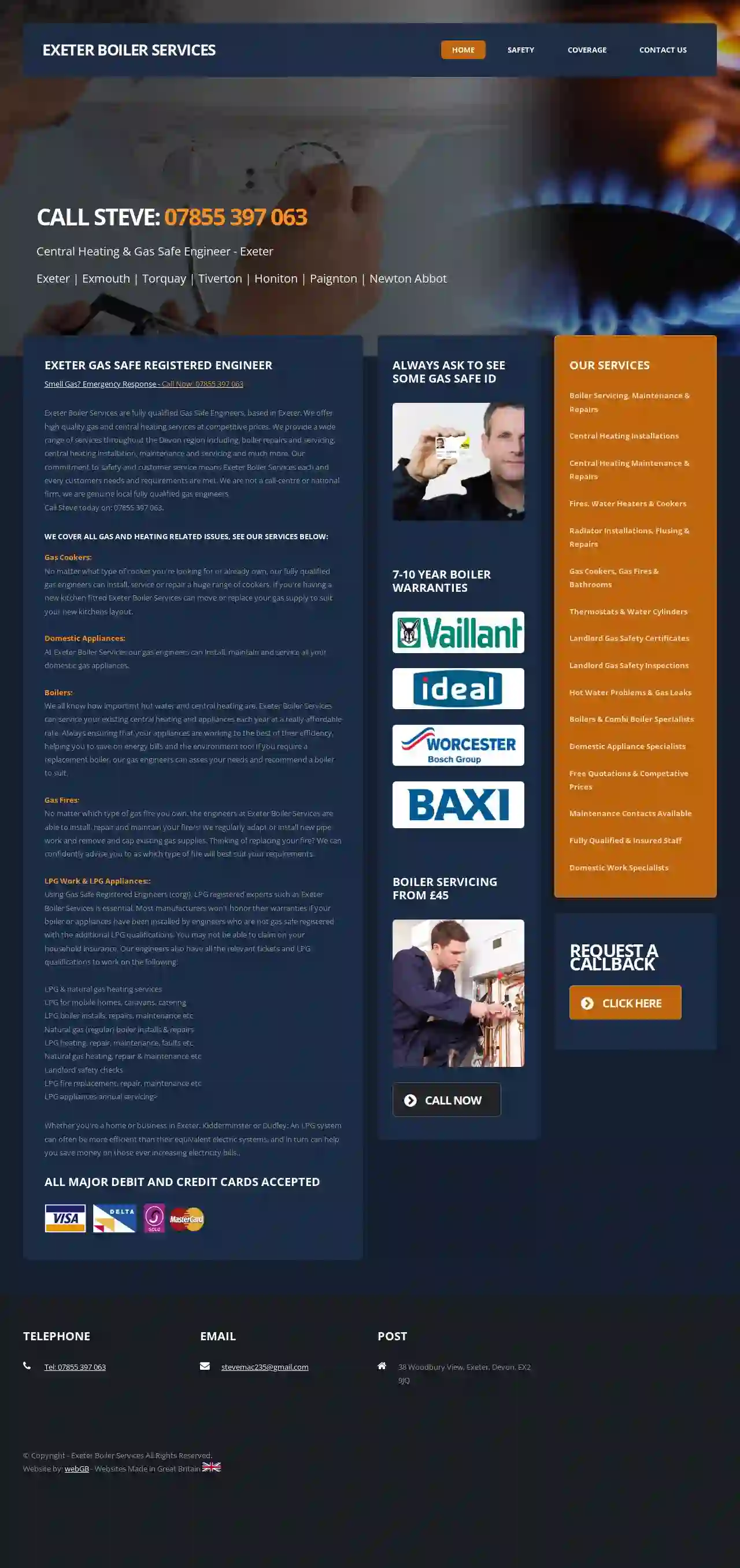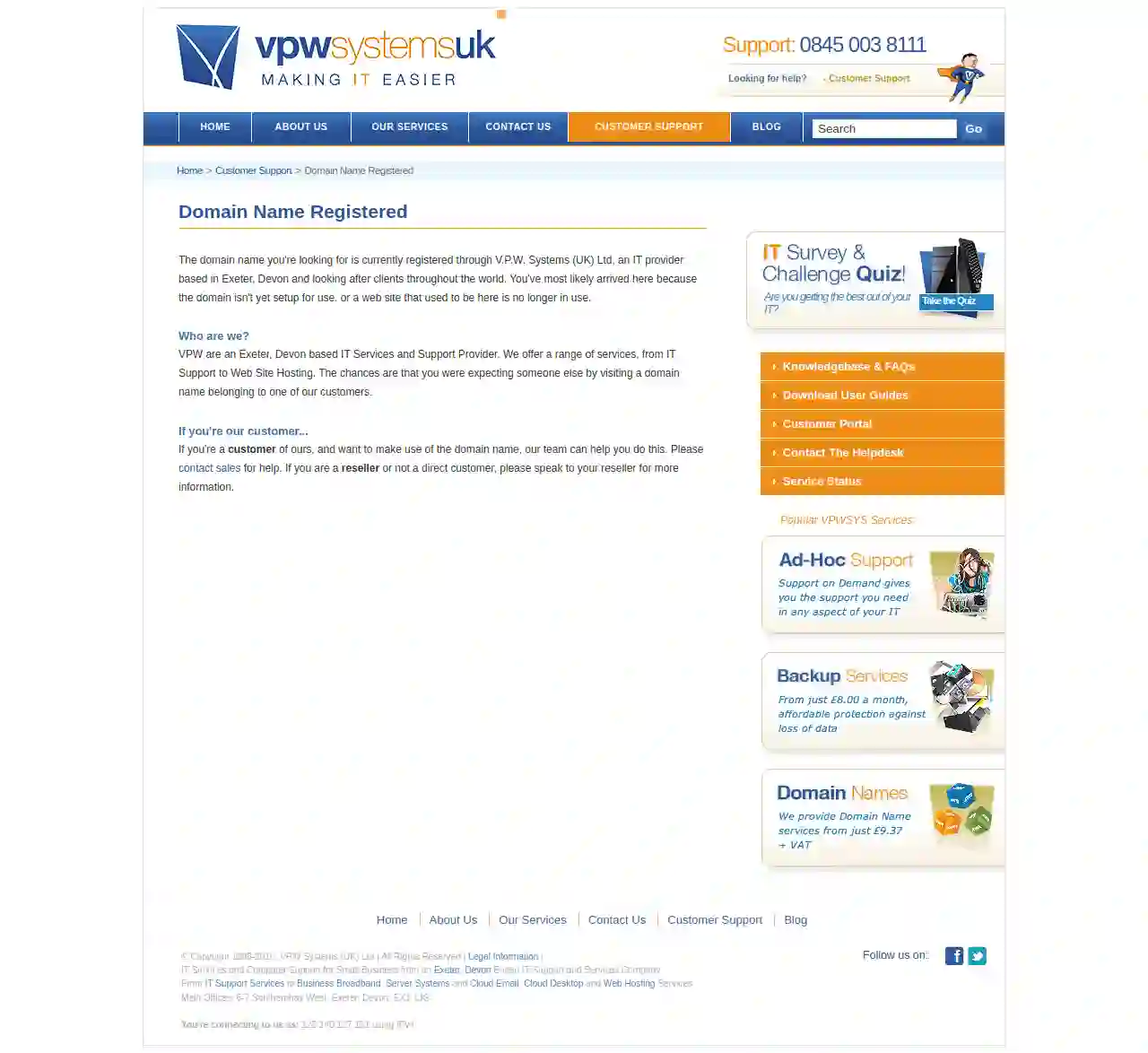Emergency HVAC Calstock
Top Emergency AC Repair in Calstock
Get up to 3 After Hours HVAC quotes for your project today! Compare profiles, reviews, accreditations, portfolio, etc... and choose the best deal.

gas central heating services exeter devon
38 Woodbury View, Exeter, EX2 9JQ, GBExeter Boiler Services is a fully qualified Gas Safe registered business based in Exeter, Devon. We provide high quality gas and central heating services at competitive prices throughout the Devon region. Our services include boiler repairs and servicing, central heating installation, maintenance and servicing, gas cooker installation, servicing and repair, domestic appliance installation, maintenance and servicing, gas fire installation, repair and maintenance, and LPG work and appliance servicing. We are committed to safety and customer service, ensuring that each customer's needs are met. We are a local, independent business, not a call centre or national firm.
- Services
- Why Us?
- Accreditations
- Our Team
- Gallery
Get Quote
M T S Heating - New & Replacement Boilers Exeter & East Devon
56 reviews29 Tristan Close, Beacon Heath, Exeter, EX4 9BT, GBMTS Heating Services offer a full suite of services covering every aspect of hot water and heating solutions. Whether you have a broken boiler, loss of hot water or require a full central heating system, all work is carried out to the highest standards of quality and safety. We are Gas and Heating Engineers who specialize in the installation, service and repair of Boilers, Central Heating Systems and Hot and Cold Water Systems. Our mission is to guide, educate and help customers obtain cost effective energy efficient products.
- Services
- Why Us?
- Accreditations
- Our Team
- Testimonials
- Gallery
Get Quote
F-Tec Property Maintenance Services - Plumbing, Electrical, Mechanical & LED Lighting
4.54 reviewsUnit 1 6 Marsh Green Road North Marsh Barton Exeter, Exeter, EX2 8NY, GBFifields Property Services (Ftec) was established in 2014 and is part of the Fifields Group. With extensive experience in construction and maintenance services, Ftec delivers customized building solutions. These solutions range from internal and external repairs to bespoke proactive maintenance programs, urgent reactive maintenance, and one-off mechanical & electrical installation projects. Ftec has a team of experienced engineers and dedicated support staff who work with clients across various sectors, including education, commercial, industrial, retail and leisure, banking facilities, healthcare, and local authorities. Located near Exeter, Ftec's head office provides convenient access to major routes across the South West, enabling them to deliver fast and efficient service to Plymouth, Truro, Taunton, and Weymouth within a 2-hour radius.
- Services
- Why Us?
- Accreditations
- Gallery
Get Quote
J Searle & Son
4.942 reviews43 Fore Street, Weech Corner, Buckfastleigh, TQ11 0AA, GBW J Searle & Son Ltd is a family-run business established in 1974, serving the South Hams and surrounding areas. We offer a wide range of appliances, from washing machines and refrigerators to dishwashers and cookers. Our experienced team is dedicated to providing excellent customer service and expert advice. We pride ourselves on our competitive prices and comprehensive after-sales service. We are committed to offering a personal touch and ensuring that our customers receive the best possible experience.
- Services
- Why Us?
- Accreditations
- Gallery
Get Quote
GASLEC Ltd
4.7159 reviewsExeter, GBEstablished since 2001, GASLEC is a local and independent gas, heating and electrical company. Our team of expert technicians are Gas Safe Register members, NAPIT and NICEIC approved, and members of the Chartered Institute of Plumbing and Heating Engineering (CIPHE). We offer a range of services including boiler installation, repairs, and servicing, as well as electrical services such as rewiring, domestic electrical repairs, and electrical testing. We also provide plumbing services, including radiator installation, thermostat and controller installation, and underfloor heating installation. Our team is dedicated to providing fast, reliable, and professional services to our customers.
- Services
- Why Us?
- Accreditations
- Our Team
- Testimonials
- Gallery
Get Quote
Safexe
545 reviewsExmouth, GBSafexe is a family run business based in Exmouth, Devon. We supply our customers with all aspects of gas work, heating and general plumbing. From tap repairs to full central heating systems and new bathroom installations. Our fully qualified, friendly plumbers strive to meet your needs. At Safexe we're in it to make a living, not a killing so competitive pricing is assured. We're passionate about what we do. Customer service and high quality workmanship are our top priorities. We cover Exmouth, Sidmouth, Exeter and surrounding areas. We work hard to please you the customer.
- Services
- Why Us?
- Our Team
- Testimonials
- Gallery
Get Quote
Modern Heating & Cooling Solutions Ltd
44 reviewsUnit 2, Swift Industrial Estate, Kingsetignton, Newton Abbot, TQ12 3SH, GBModern Heating and Cooling Solutions Ltd was founded in 2014 by Mark Glanville with a vision to deliver exceptional customer service and top-quality workmanship. In 2021, Craig Hazelwood, a highly skilled engineer, joined as a director, bringing years of experience to help Mark achieve his vision. We understand that when you need a plumber, heating, or renewable energy engineer, you want someone reliable, trustworthy, and skilled. That's why we employ only the best engineers in the business. Our team is fully qualified and experienced, dedicated to providing our customers with the best possible service. We are a leading provider of heating, cooling, plumbing services, and Renewables in Newton Abbot, Devon, and the South West of England. We offer a wide range of services, including bespoke and creative heating and cooling installations, boiler installation, servicing, and repairs, bathroom installations, renewable energy solutions such as solar panels, EV chargers, battery storage, air-source heat pumps, ground source heat pumps, Zeb Boilers, and servicing. We also provide underfloor heating, MVHR installation, air conditioning servicing, power flushing, thermodynamic solar, and commercial mechanical services. We are committed to providing our customers with the highest quality of service and workmanship. All of our heating and plumbing engineers are fully qualified, trustworthy, and reliable. We also offer a customer promise to provide impartial advice and listen to our customers' requirements to ensure they get the end result they need, whatever the job. In 2020, we expanded to include an Electrical Division known as Modern Electrical Solutions to meet the growing demand from customers for a combined and fully connected service. Modern Electrical Solutions separated as an individual company in October 2021, known as Modern Electrical Solutions (SW) Limited. We can still offer combined M&E packages to all our customers, making us your one-stop shop for all your mechanical and electrical needs. Whether you need a new heating system installed, upgrading your current system to a more efficient renewable solution, your boiler serviced, or a new bathroom fitted, Modern Heating and Cooling Solutions can help. We offer a free consultation service to discuss your requirements and provide a tailored quote.
- Services
- Why Us?
- Accreditations
- Gallery
Get Quote
TF Solutions, Exeter
Exeter, GBTrusted Air Conditioning, Refrigeration and Heat Pump Wholesaler. Call: 03300415283. We are a leading supplier of air conditioning, refrigeration and heat pump products, with a wide range of products from top brands. Our commitment to you is to provide the best service and product range, with a reputation for reliable customer service. We strive to innovate in every part of our business to help all our customers, large and small, to grow with us.
- Services
- Why Us?
- Our Team
- Testimonials
- Gallery
Get Quote
K S Engineering - Heating Specialists
3.919 reviews6-7 Southernhay West, Exeter, EX1 1JG, GBVPW Systems (UK) Ltd is an IT Services and Support Provider based in Exeter, Devon. They offer a range of services, including IT Support, Web Site Hosting, Business Broadband, Server Systems, Cloud Email, Cloud Desktop, and Web Hosting Services. VPW Systems primarily serves clients worldwide, helping them with domain name registration and website setup.
- Services
- Why Us?
- Gallery
Get Quote
Midwest Comfort Heating & Cooling LLC
4.9190 reviewsElk Grove, 56480, GBAIR CONDITIONING REPAIR, FURNACE REPLACEMENT, AND MAINTENANCE IN ELK GROVE, IL. Over 5 years Of Experience, detail oriented, Flat fees, no up-charges upon arrival, 100% Satisfaction Guaranteed. We offer timely and reliable AC repair services to ensure you stay comfortable during the hot summer months. Our team installs top-of-the-line air conditioning units to keep your home cool and comfortable. Our ductless mini split air conditioners are perfect for those seeking a cost-effective, energy-efficient cooling solution. Our mini AC split systems provide targeted cooling to specific areas of your home, making them perfect for smaller spaces. Our heat pump services provide heating and cooling solutions, perfect for year-round comfort. Our air handler installation and services work with your existing HVAC system to improve indoor air quality and keep your home comfortable.
- Services
- Why Us?
- Testimonials
- Gallery
Get Quote
Over 12,692+ HVAC Companies onboarded
Our HVAC contractors operate in Calstock and beyond!
HVACCompaniesHub has curated and vetted Top HVAC Businesses in and around Calstock. Find a trustworthy business today.
Frequently Asked Questions About Emergency HVAC Services
- Improve Energy Efficiency
- Extend System Lifespan
- Prevent Costly Repairs
- Enhance Indoor Air Quality
- Identify Potential Problems Early
- Ensure System Reliability
- No heat in freezing weather
- No air conditioning in extreme heat
- Gas leaks
- Carbon monoxide leaks
- Frozen pipes
- Water leaks from HVAC equipment
- Electrical problems with your system
What are the benefits of a preventative HVAC maintenance plan?
What is a zoning system, and do I need one?
What is considered an HVAC emergency?
What is carbon monoxide, and how can it affect my HVAC system?
What are the benefits of a preventative HVAC maintenance plan?
- Improve Energy Efficiency
- Extend System Lifespan
- Prevent Costly Repairs
- Enhance Indoor Air Quality
- Identify Potential Problems Early
- Ensure System Reliability
What is a zoning system, and do I need one?
What is considered an HVAC emergency?
- No heat in freezing weather
- No air conditioning in extreme heat
- Gas leaks
- Carbon monoxide leaks
- Frozen pipes
- Water leaks from HVAC equipment
- Electrical problems with your system